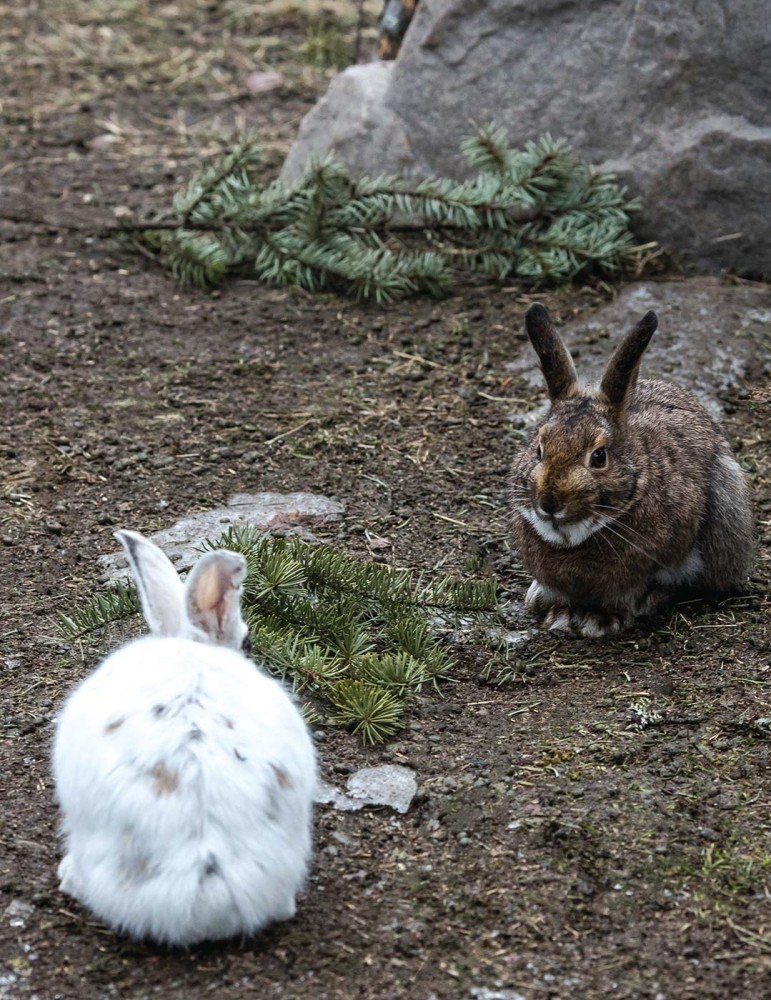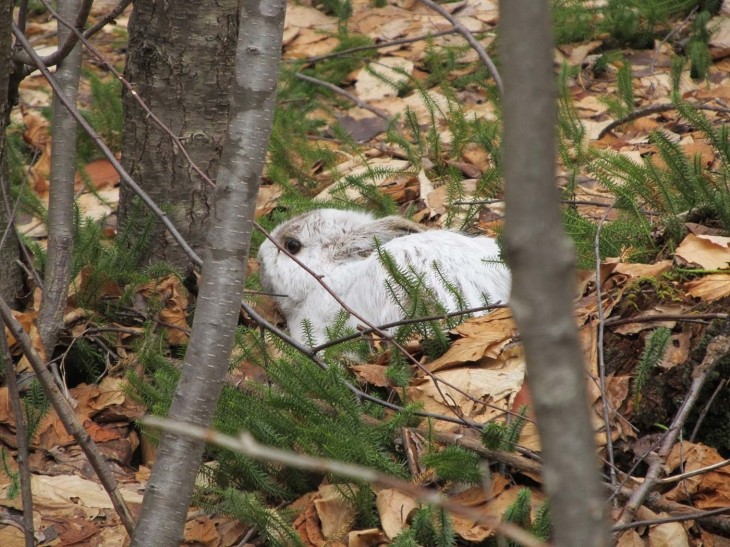
Years ago, I spent considerable time investigating factors that affected the distribution and abundance of snowshoe hares. That investigation was part of a larger project examining what limited bobcats in Maine. Because hares made up nearly 75 percent of Maine bobcats’ diet, understanding hare distribution patterns was essential. During my fieldwork, I readily found evidence of hares including droppings, clipped twigs where they fed, and tracks in the snow. Yet, I rarely saw them. Much of the ability of hares to avoid detection can be attributed to their seasonal molts that result in distinct summer brown and winter white coats. Hares are one of 21 species of birds and mammals worldwide that have this adaptation to reduce detection by other animals. Unfortunately for hares, one of the consequences of climate change has been a reduction in the number of days with snow on the ground. As snow cover arrives later and leaves earlier, hares that switch from brown to white in autumn or white to brown in spring can find themselves the wrong color for their environment. This can have lethal consequences as they are easily seen by a hungry fox, bobcat, or owl.
The ecological importance of snowshoe hares cannot be overstated – they literally fuel the food chain in the forests that span much of the northern United States and most of Canada. Their influence on northern carnivores in particular is widely known by the dramatic 10-year cycle, where hare populations can increase to more than 1,000 per square mile and then crash to a few survivors when their food supply runs out. Lynx, hare-consuming specialists, respond with a similar rollercoaster pattern of abundance. Given the importance of snowshoe hare to northern ecosystems, a diverse group of field biologists and geneticists is investigating the process of color change and how a changing climate may affect long-term survival of hares.
Color change versus climate change
It is clear that genetics determine the ability of individual hares to switch coat color. Changing day length (photoperiod) in autumn and spring has a major role in the timing of the biannual molt. But hares also respond to the presence or absence of snow when transitioning between coat colors. In western Montana, hares demonstrated a more rapid molt to brown during springtime when snowmelt was earlier and faster. Still, early snowmelt resulted in numerous white hares on snowless backgrounds. Among a large sample of radio-collared hares in Montana, weekly survival rates declined 7 to 12 percent when their coat color was different from the background color. This is sufficient to cause severe population declines in the absence of future adaptive responses by hares.
Recently, photographic records from trail cameras revealed differences in mismatch vulnerabilities among hares in New England, Colorado, and Canada. Hares in New England experienced the highest frequency of white mismatch during both fall and spring molts because snow is now arriving later (after hares have molted to white) and melting away sooner (before hares molt to brown). Based on a variety of computer projections, the annual duration of snowpack will decrease by 29 to 35 days by midcentury and 40 to 69 days by the end of the century within the range of snowshoe hares. Such changes will have consequences.
Populations of snowshoe hares most vulnerable to a changing climate occur along the southern edge of their geographic range, where the duration of snow coverage may already limit them. Researchers at the University of Wisconsin considered this while examining the distribution of hares in a broad band across central Wisconsin, the southern edge of hares in that state. Previous inventories in 1980 provided a baseline for comparison. Returning to many of the same sites in 2014, there was an obvious northward shift in the distribution of hares. In addition to habitat loss, the current duration of snow cover was identified as a principle factor contributing to the shift. Only a few of the historical sites that were still occupied in 2014 had snow cover duration of fewer than 110 days – an apparent threshold below which local extinction probability increases markedly for mismatched hares. In addition to the range contraction in Wisconsin, similar patterns have been observed in Michigan and Pennsylvania. In Michigan, an increase in temperatures and a reduction in the duration of snow cover were associated with a nearly 30-mile northward shift in the distribution of hares during the last 20 years.

Can hares adapt to shorter winters?
Responses to environmental variation by snowshoe hares can be examined on a short-term and long-term basis. In the short-term, individual hares may adapt by altering their behavior when they experience a color mismatch with their environment. For this to happen, hares would need to be aware that their coat color was a mismatch and to make some adjustments. Snowshoe hares are indeed capable of altering their behavior to reduce predation risk. For example, under a full moon, they increase their use of high-cover areas or decrease their movements, thus reducing their exposure to predators. In Alaska, willow ptarmigan, a ground-nesting bird related to ruffed grouse, molt their summer brown feathers for winter white ones. Ptarmigan also alter their feeding patterns during vulnerable molting periods to select habitats that effectively conceal their plumage. As they transition between colors, birds select low-quality foods in secure cover rather than high-quality foods with little cover. Can hares make similar adjustments?
During my work in Maine, I recorded more than 1,200 captures of hares during spring and autumn census bouts. Hares were actively molting during these periods, and the number of hares that were partly or mostly white while there was little or no snow in the forest surprised me. Because autumn or spring molts can last 70 to 90 days, I was curious if a mismatched hare realized that it was so conspicuous. Essentially, does a hare know that it is white when the world is brown? To address that question, I compared the density of understory vegetation at capture sites to each hare’s coat color. My prediction was that white or mottled hares would spend more time in dense vegetation to avoid detection. I was partially correct. In two of the six census bouts, white or mottled hares did indeed select denser vegetation than did brown hares. However, more recent work in Montana using radio-collared hares showed that mismatched hares did not select sites with denser vegetation, and white hares did not seek out patches of snow if available but seemed to prefer bare ground where they were especially visible. This response likely explains the higher mortality rate of mismatched hares observed in that study.
In the Pacific Northwest, there are long-established populations of snowshoe hares that do not molt into a white coat during winter. These winter-brown hares are most common in coastal regions of Oregon, Washington, and southwestern British Columbia where snowfall is rare. However, both winter-brown and winter-white color phases occur in the Cascade Mountains where there is snow, and they even coexist at some localities. Detailed genetic analysis has revealed that the winter-brown phase of hares in this region is a consequence of ancestral interbreeding between snowshoe hares and black-tailed jackrabbits – a species that stays brown year-round. That cross resulted in the introduction of a gene that is responsible for maintaining a winter-brown coat in snowshoe hares that possess it.
At the University of Montana, Scott Mills and his collaborators have been exploring the idea that populations of hares that contain a mix of winter-brown and winter-white individuals may be critical to long-term survival of snowshoe hares. According to Mills, these polymorphic populations (those that contain both color phases) may be “the special sauce for rapid evolutionary rescue.” Specifically, these populations have the capacity to spread the winter-brown gene if reduced duration of snow cover makes that trait a survival advantage. Mills and his collaborators also have identified seven other species, including Arctic foxes, three species of weasels, and three other species of hares that seasonally change coat color and also have polymorphic populations in regions where snowfall is infrequent. Such genetic hotspots may warrant special attention to maintain connectivity with winter-white populations if climate change also threatens these species.
Building on the work by Mills, Matthew Jones, also at the University of Montana, found that there might be limits to the spread of the winter-brown gene to hare populations beyond the Pacific Northwest. That gene was found in about 1 percent of essentially winter-white populations in Montana that are separated from winter-brown populations by roughly 350 miles. At greater distances, hare populations in Alaska and Pennsylvania are clearly genetically separated from the polymorphic populations in western Washington. Yet winter-brown hares have been captured in both Alaska and Pennsylvania. These winter-brown hares are quite rare, and genetic evidence indicates that a mutation independent of the ancestral crossbreeding with jackrabbits is responsible. As climate change continues to threaten hare survival, Jones speculates that such independent mutations will be a more likely rescue than the slow, limited spread of the winter-brown coat gene from the Pacific Northwest.
From these research efforts, we see that snowshoe hares are already experiencing the effects of climate change. Although the fate of their populations in the future is not known, it seems likely that additional declines in abundance and distribution will happen. Continued changes in weather patterns, including the extent and duration of snow cover, will affect many high-latitude species that have evolved specific adaptations to winter. Snowshoe hares are just one example. Being attentive to these population trends and their correlation to warmer climate patterns can inform land management and conservation decisions, and perhaps provide opportunities to limit the impacts of climate change on these iconic animals in the Northeast.




